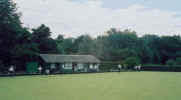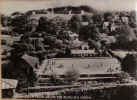As part of the celebration of the Club's 125th birthday in 2004, a little booklet has been prepared by Jim Colraine (after initial research by Bill Lyon) and I have copied large chunks for the following 'potted history'. (They say imitation is the sincerest form of flattery..)
Skip to particular year Click this link to see summary of recent years
The town of Bearden has a relatively recent history for an area that boasts Roman remains; parts of Antonine's Wall are nearby. The parish was known as New Kilpatrick, and when the railway branch line was built in 1863, the local station was called Bearsden (after the name of a local house) to avoid confusion with Old Kilpatrick station which is beside the modern Erskine bridge over the Clyde. The Bowling Club was originally called New Kilpatrick Bowling Green when it was gifted by the Revd J.E. Campbell Colquhoun 'for the benefit of feuers of his estate' in 1869, although it was a small area then.
Early days
By 1908, the local 'Bearsden & Milngavie Herald' is reporting the opening of the green "in dull but otherwise favourable conditions" and remarking on the presence of one of the founder members of the Club, a Mr John Cruickshanks who served as treasurer for over 50 years. When he joined there were only ten members, but numbers increased and a full length green was laid in 1879.
In 1908 the club joined the Glasgow Bowling Association, and a Greenkeeper was appointed at the wage of 25/- (£1.25) per week!
The Ladies
In 1912, after a request, it was agreed that wives, daughters and sisters of members would be allowed to play on the green from 2-4.30 p.m. on Wednesday and Friday afternoons, although Ladies were not admitted as members until 1928. In 2013 the ladies finally became full and equal members.
The Great War
The 1914-18 war had its effect on the Bowling Club as on everything else, with 30 members gathering to acknowledge the services of the Club Secretary, a Mr McMillan, as he proceeded on 'Active Service'. Wounded soldiers were entertained on the green in August 1916, and the Club Directors "heard, with regret, of the death of the eldest son of the club president, Lt Reid, while gallantly leading his men into action."
The pavilion
 In
1920, a tea pavilion was built on the South side of the green. This was
adapted to serve as the greenkeeper's bungalow in 1937 when our present
Clubhouse was built. This was later adapted and is still in use as our bowls
house and changing rooms.
In
1920, a tea pavilion was built on the South side of the green. This was
adapted to serve as the greenkeeper's bungalow in 1937 when our present
Clubhouse was built. This was later adapted and is still in use as our bowls
house and changing rooms.
Weather report
The weather was as variable in those days as it is now, with 'wet and stormy weather until early June hindering attendance' in 1926, although later in the year 'drought burned the green and spoiled accuracy of play'. (Good excuse that!!)
Some costs!
 In 1934, the new Pavilion was valued at £500 and the old Bowl House at
£100. Our present Clubhouse was built in 1937 for an estimated cost of £1000.
Click on the image to see a view of the green in its sylvan surroundings taken
in the 1930s.
In 1934, the new Pavilion was valued at £500 and the old Bowl House at
£100. Our present Clubhouse was built in 1937 for an estimated cost of £1000.
Click on the image to see a view of the green in its sylvan surroundings taken
in the 1930s.
World War II
Celebration for the club's Diamond Jubilee in 1939 were cancelled due the outbreak of the Second World War, and in 1940 the Clubhouse was requisitioned by the Army for the Home Guard. Captain Mainwaring would surely have been at home here!
 This
photograph shows the clubhouse in the 1960's, before the
Donaldson Lounge was added.
This
photograph shows the clubhouse in the 1960's, before the
Donaldson Lounge was added.

















